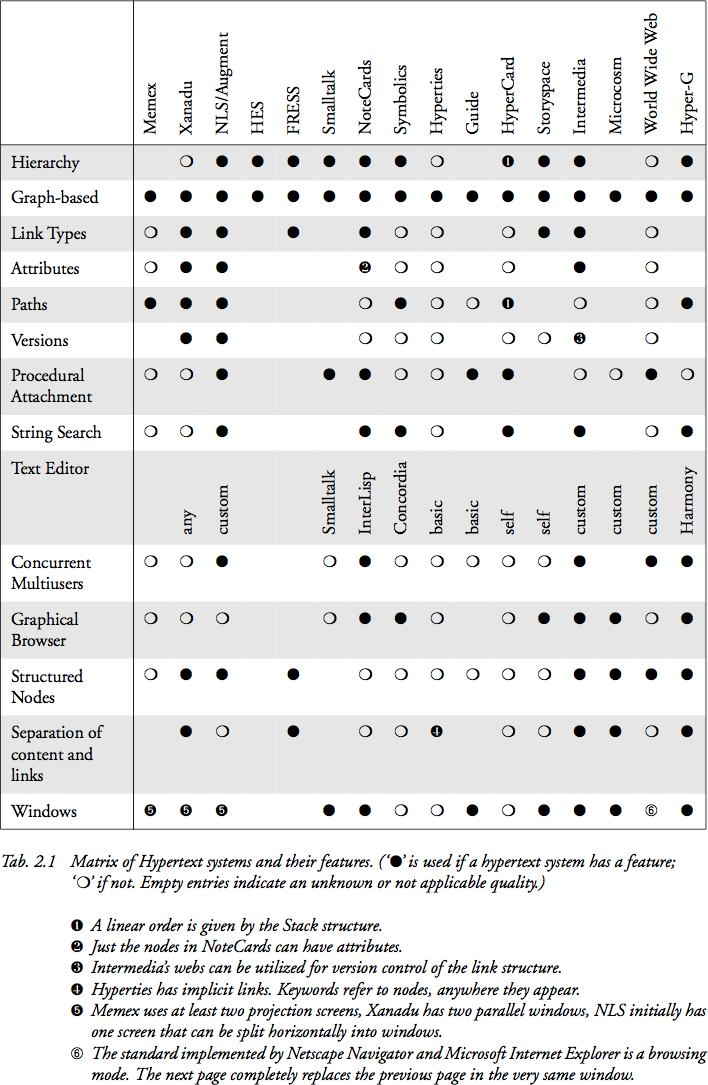2.2.1 Hypertext Feature Matrix
in Vision and Reality of Hypertext and Graphical User Interfaces
This section builds on top of Jeff Conklin’s record and extends it for the hypertext systems presented in this discussion. Conklin’s feature dimension consists of [Conklin 87, p. 21],* * The question whether the hypertext system supports images will be skipped.

Hierarchy: Is there specific support for hierarchical structures?
Graph-based: Does the system support nonhierarchical (cross-reference) links?
Link Types: Can links have types?
Attributes: Can user-designated attribute/value pairs be associated with nodes or links?
Paths: Can many links be strung together into a single persistent object?
Versions: Can nodes or links have more than a single version?
Procedural Attachment: Can arbitrary executable procedures be attached to events (such as mousing) at nodes or links?
String Search: Can the hyperdocument be searched for strings (including keywords)?
Text Editor: What editor is used to create and modify the content of the nodes?
Concurrent Multiusers: Can several users edit the hyperdocument at the same time?
Graphical Browser: Is there a browser which graphically presents the nodes and links in the hyperdocument?
These categories will be extended by the following questions:
Structured Nodes: Can links refer to specific location within the nodes?
Separation of Content and Links: Is the linking information stored separately from the documents?
Windows: Do nodes open in new windows?
Jeff Conklin could only take into account existing hypertext systems up to 1987. From his table the matrix in Tab. 2.1 takes information about Xanadu, NLS/Augment, NoteCards, Symbolics, Hyperties, and Intermedia. The list will be complemented by Memex, HES, FRESS, Smalltalk, Guide, HyperCard, Storyspace, Microcosm, Hyper-G, and the World Wide Web. Tab. 2.1 shows the new matrix.
Just a few of Conklin’s statements needed to be updated. Symbolics Document Examiner has a graphical browser as can be seen in Fig. 2.8. The corresponding editor is Concordia instead of ‘None’. The other update touches upon Intermedia’s support for versioning. As we have seen the concept of webs can be utilized for versioning of the link structure.
Hierarchy m l l l l l l m ∂ l l m l
Graph-based l l l l l l l l l l l l l l l l
Link Types m l l l l m m m l l m
Attributes m l l ∑ m m m l m
Paths l l l m l m m ∂ m m l
Versions l l m m m m m ∏ m
Procedural Attachment m m l l l m m l l m m l m
String Search m m l l l m l l m l
Text Editor any custom Smalltalk InterLisp Concordia basic basic self self custom custom custom Harmony
Concurrent Multiusers m m l m l m m m m m l l l
Graphical Browser m m m m l l m m l l l m l
Structured Nodes m l l l m m m m m m l l l l
Separation of content and links l m l m m π m m l l m l
Windows ΠΠΠl l m m l m l l l Šl
Matrix of Hypertext systems and their features. (‘l’ is used if a hypertext system has a feature;
‘m’ if not. Empty entries indicate an unknown or not applicable quality.)
∂ A linear order is given by the Stack structure.
∑ Just the nodes in NoteCards can have attributes.
∏ Intermedia’s webs can be utilized for version control of the link structure.
π Hyperties has implicit links. Keywords refer to nodes, anywhere they appear.
ΠMemex uses at least two projection screens, Xanadu has two parallel windows, NLS initially has
one screen that can be split horizontally into windows.
≈ The standard implemented by Netscape Navigator and Microsoft Internet Explorer is a browsing
mode. The next page completely replaces the previous page in the very same window.
![]() For a free PDF version of Vision and Reality of Hypertext and Graphical User Interfaces (122 pages), send an e-mail to:
For a free PDF version of Vision and Reality of Hypertext and Graphical User Interfaces (122 pages), send an e-mail to:
![]() mprove@acm.org I’ll usually respond within a day. [privacy policy]
mprove@acm.org I’ll usually respond within a day. [privacy policy]